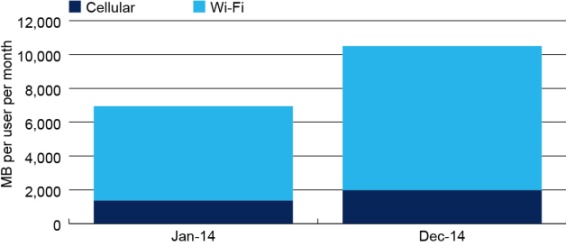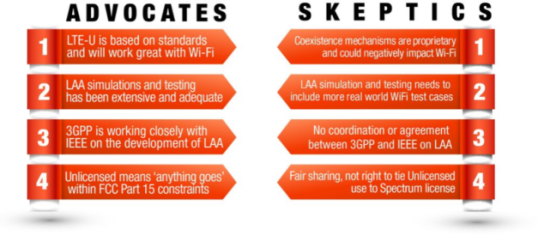 Reading some of the literature about LTE-U (and LAA) leads you to believe that its deployment is a foregone conclusion: operators love it; vendors support it, and products will be available within months. But operators lack the sales channel into the enterprise where LTE-U is envisioned to be deployed and provide most value.
Reading some of the literature about LTE-U (and LAA) leads you to believe that its deployment is a foregone conclusion: operators love it; vendors support it, and products will be available within months. But operators lack the sales channel into the enterprise where LTE-U is envisioned to be deployed and provide most value.
While LTE-U may find its way into the handset fairly rapidly, its path into the Wi-Fi access nodes will be long and arduous as that ecosystem is not particularly friendly to LTE-U (Cisco for example), while the channels of the small cell vendors, such as Huawei and Ericsson, into the enterprise are less established.
The enterprise is the arena where LTE-U and Wi-Fi will fight it out, and in this, you have to favor the incumbent technology only because of its established market presence and channels. Even from a technology perspective, Wi-Fi has a path to integrate into the LTE network through LWA (LTE Wi-Fi link aggregation). LWA is a viable alternative into the enterprise and removes certain obstacles which enhance its prospects vis a vis LTE-U.
Whether or not LTE-U is more efficient than Wi-Fi is irrelevant as the market force is more powerful than technology performance. Moreover, LTE-U will not provide any cost savings – but in fact will add cost. But what LTE-U provides is relief to the operators on the planning issue which has bogged down small cells deployments. LTE-U does not have to be planned and can be deployed on ad-hoc basis where and when needed. This is a major positive feature. But the fundamental questions remain. Will there be room for two unlicensed band technologies? If everything that can be achieved with Wi-Fi can be done with LTE-U/LAA and without all the market issues to contend with, will LTE-U/LAA make it? Can LTE-U/LAA find the oxygen to grow in the enterprise/indoor market while the market windpipes are closed? There is another point to consider: LTE-U is viewed as a way for operators to save licensed spectrum by shifting traffic to unlicensed bands; but will this tarnish the image of LTE? Unlicensed spectrum is liable for higher interference and there’s less control over performance. People are used to Wi-Fi and are more tolerant to performance problems when the service is free. But how will LTE-U in 5 GHz impact the image of the carriers and the services they provide? In principle, it is great concept to have users unaware of the service technology through seamless selection, but this has the potential to backfire. Carriers built their business on ensuring SLAs with planned networks where interference is managed. This cannot continue with LTE-U and requires some thought on part of the carriers on how to approach this issue. LTE-U is a great idea – but its success is far from being a foregone conclusion and may prove too expensive and risky, certainly if the modus operandi remains the same. What is required to help make it successful is a complete change in the go-to-market strategy that enables deployments in the enterprise market.


Frank,
I think one of the major issues will in fact be the handsets, assuming an 18 month refresh rate (half way between 12 and 24) then it will be 2017 before there are significant numbers of handsets available let alone useable, As far as AP’s. small-cells are concerned my guess is they are more advanced.
Regarding LTE-U v LTE-LAA, the latter will become a standard irrespective of whether its used. I couldn’t comment on LTE-U but would guess that AT&T or T-Mobile may wish to use it on an indoor basis for existing Enterprise customers.
Peter, you have a good point, in general it’s harder to integrate into handsets than the small cells side where more flexibility is available.
I sort of lumped LTE-U and LAA in the same class – and yes, becoming and standard and actually getting used are two different things.
Everything I saw tells me AT&T is not excited about the technology. Perhaps because they have a large Wi-Fi install base.
AT&T also has just installed 30,000 enterprise small cells, so yes maybe they don’t need to
LAA can be seen as more of a metrocell/hotspot play, rather than for the indoor enterprise that is suggested – there seems to be plenty of spectrum and correspondingly less interference indoors for cellular. LAA will initially use a supplementary downlink for e.g. best effort/background traffic so the impact on perception of an operator service may not be damaged in the way that you suggest.
Good point on the quality issue – I would think that muLTEfire would have more of a perception downside issue that LTE-U/LAA
Hi Frank,
I would like to hear your thoughts on Qualcomm supported LWA. And how the standards development between IEEE 802.xx and 3GPP play about for listen before talk and unconstrained duty cycling?
I hope that the industry will take note of the many studies conducted by Cable Labs to prove that LTE-U does have impact on consumers use of Wi-Fi. 3GPP so far has not permitted IEEE, the Wi-Fi Alliance, or the Wi-Fi community to participate in its standards development process.
Thanks,
Harish
Hi Harish, Anytime multiple technologies share spectrum you are bounded to have coexistence issues; the same when you have more users using a single technology – performance will degrade. So the issue boils down to the access mechanism for the air interface and how they share the same medium. Clearly there will be contention between the two technologies and the performance will degrade. As for collaboration, this is in the political domain, but the same companies participating in the IEEE are also in 3GPP and vice versa. I am not sure what it would mean for IEEE specifically to be in 3GPP since the IEEE as the 3GPP are made of the member companies.
If you like to discuss more, feel free to drop me a note by email through the contact page.